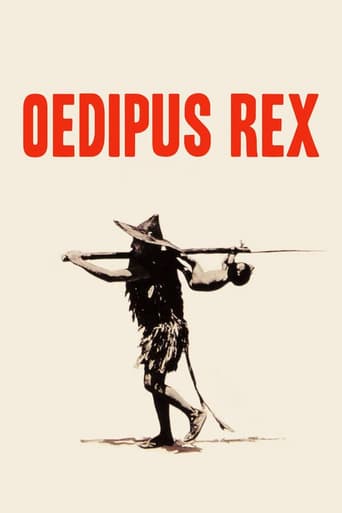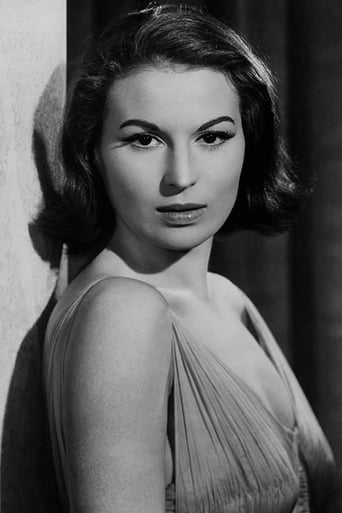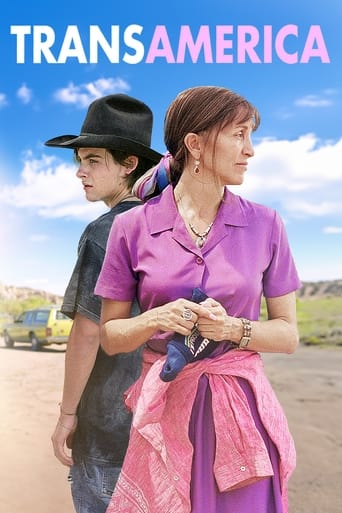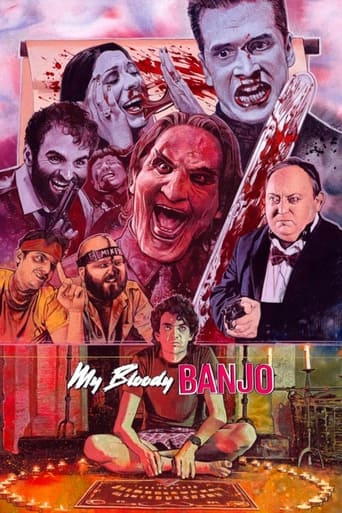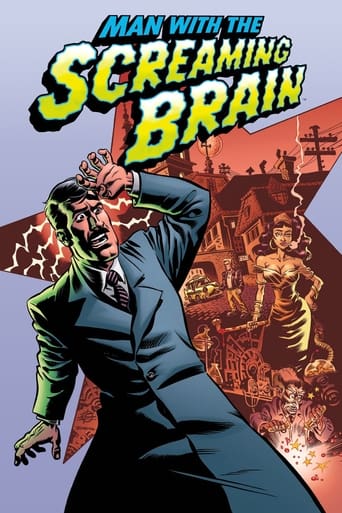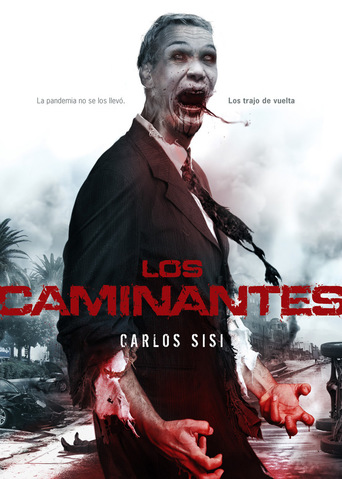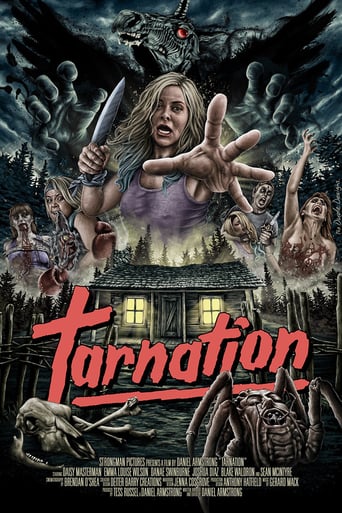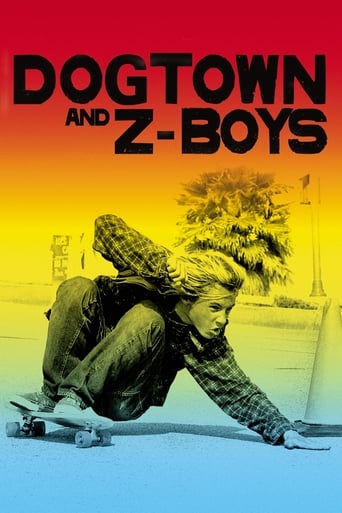Oedipus Rex (1967)
In pre-war Italy, a young couple have a baby boy. The father, however, is jealous of his son - and the scene moves to antiquity, where the baby is taken into the desert to be killed. He is rescued, given the name Edipo (Oedipus), and brought up by the King and Queen of Corinth as their son. One day an oracle informs Edipo that he is destined to kill his father and marry his mother. Horrified, he flees Corinth and his supposed parents - only to get into a fight and kill an older man on the road…
Watch Trailer
Free Trial Channels
Cast


Similar titles
Reviews
Good concept, poorly executed.
An absolute waste of money
It’s fine. It's literally the definition of a fine movie. You’ve seen it before, you know every beat and outcome before the characters even do. Only question is how much escapism you’re looking for.
Each character in this movie — down to the smallest one — is an individual rather than a type, prone to spontaneous changes of mood and sometimes amusing outbursts of pettiness or ill humor.
one of films who remands. the rules of Greek tragedy. the limits of interpretation. the manner to use the myth as contemporary mirror. the art of Piero della Francesca. the conflict between past and present. a film of actors. because each trace of acting defines not the vision of Pasolini about the fate of king from Thebes but its search of truth. the truth - basis of all. Edipo re impress. for atmosphere, for costumes and the use of myth.the eyes of Franco Citti. the presence of Silvana Mangano. the first scenes who are parts from a possible Visconti. the end as warning about the price of fight against yourself. Edipo re is support for reflection. not a new version of well known myth because the important details of myth are insignificant. not example of high art. because it is far to be a show. it is only exploration of meanings. and the sketch about different forms of pride and sacrifice. looking for authenticity. precise definition of life.
Pier Paolo Pasolini's Oedipus Rex is a relatively faithful adaptation of Sophocles' Greek tragedy Oedipus the King. Beginning in 1920's Italy, a baby boy is born and is instantly envied by the displaced father. The setting then changes to ancient times, where a baby boy is being carried out into the desert by a servant to be left out to die from exposure. He is eventually picked up by a shepherd, who takes him back to the King and Queen of Corinth, who adopt the youngster and love him like one of their own. The child grows up to be Edipo (Pasolini's frequent collaborator Franco Citti), an arrogant youth who wishes to see the world for himself. And so he set out on the road to Thebes, the place of his birth.Plagued by a prophecy that dictates he is destined to murder his father and marry his mother, Edipo is a tortured but intuitive soul. He murders a rich man and his guards after they demand he clear a path for them on the road, and later frees a town from the clutches of a Sphinx by solving its riddle. Staying true to his own recognisable style, Pasolini tells the story of Oedipus not with a sweeping narrative, but through a collection of comedic, violent and often surreal vignettes, the most bizarre and ultimately thrilling being the scene in which Edipo murders the guards. He runs away from them as they chase him, before charging at them one by one and cutting them down. It's a moment without any real motivational insight, offering but a glimpse into Edipo's damaged psyche.Post-Freud, the story of Oedipus cannot be experienced without reading into the incestuous and patricidal undertones. But these themes are less explored by Pasolini than the idea of Edipo being ultimately responsible for his own downfall. Rather than the inevitability of fate, Edipo creates his own path, committing murder on a whim and marrying while blinded by ambition. For a bulk of the film, Pasolini keeps the audience at arm's length, favouring his own brushes of surrealism over a traditional narrative. While this may be occasionally frustrating - the pre-war scenes than book-end the film seem out of place and confusing - Citti's wide-eyed performance is a fantastic distraction, and the Moroccan scenery helps provide a ghostly, Biblical atmosphere as well as a beautiful backdrop.
This tale of Oedipus starts off and ends in the twentieth century, though for the most part is set in a primitive version of ancient Greece. There is not much rational connection between the stories, but Pasolini manages to forge himself a free pass on that one. Whilst the Oedipus Complex theme of the first story is meant to be taken quite literally, and is basically autobiographical, the middle story, recognisably Sophoclean, is more, in my opinion, meant to be about an angry confused man who cannot stomach his fate nor confront truths about his identity. As both sections do genuinely feel autobiographical they knit together just fine.The first section of the film set in the 1920s is the best piece of filming I have seen from Pasolini and made me really excited. There's a wide open scene of children running off around a playing field on a hot piercing day, one of those thick childhood days when the emotions battened down the hatches on squire intellect. I was reminded very much of an Edith Sitwell poem (Green Flows the River of Lethe - O): "I stood near the Cities of the Plains / And the young girls were chasing their hearts like the gay butterflies / Over the fields of summer - / O evanescent velvets fluttering your wings / Like winds and butterflies on the Road from Nothing to Nowhere!" The sentiment all the more surprisingly apt given that the second part of the film is shot in what could be the ruins of Sodom and Gomorrah (the Cities of the Plains) for all we know.The rage of Oedipus, which occurs frequently in the movie could be liked to another part of the poem: "But in the summer drought / I fled, for I was a Pillar of Fire, I was destruction / Unquenched, incarnate and incarnadine // I was Annihilation / Yet white as the Dead Sea, white as the Cities of the Plains / For I listened to the noontide and my veins / That threatened thunder and the heart of roses." Part of Pasolini's drive for shooting the films seems to be to continue his fascination with ancient buildings and ruins which he demonstrated three years earlier in his superb 1964 documentary The Walls of Sana'a for which he travelled to Yemen.The end of the playing field scene features Jocasta suckling Oedipus. She gazes directly at the camera and thus the audience for a long period, in which she goes through a range of emotions, including what could be arousal, followed by disquiet, which ultimately turns into a distanced understanding. For me this is cinematically equivalent to the Mona Lisa, which is also a gay man's meditation on his mother, greatly cryptic yet provocative, set in against a natural backdrop.Silvana Mangano, who plays the mother in both parts of the movie (and would star in Pasolini's Teorema the following year), carries a lot of it. Her beauty, her alabaster skin and wispy eyebrows, her perfectly tangled plaits (which would send Fuseli to his knees), are commanding. She has an artistic skill that eclipses that of Franco Citti (Oedipus) and Ninetto Davoli (Thebes' crier) quite totally. Franco Citti's lack of skill, whilst occasionally infuriating in the context of the story (his is not the demeanour of a king) do however lend the film a level of authenticity, given the primary motive of this sequence, which was to demonstrate a pained adolescent fury and denial, which was ignorant at its base.There's an unusual device of writing characters' thoughts in black lettering on a white background, which doesn't quite work but which would be far better than the presumable alternative of camera-faced soliloquies.Some of the locations in the movie felt truly dream-like to me, for instance the unkempt walled piazza-garden of Jocasta, the crumbled ruin where Oedipus meets a naked adolescent girl on his peregrinations, the mountainous areas between cities.The props in the movie are cheap and fantastical but quite brilliant, the wind-blown hands on the milestones to Thebes, the quite bizarre head gear of the Pythoness, the soldiers, and King Laius. Modern producers who delight in throwing money at movies, please note how Pasolini achieves far better results with great economy.Cultural references abound, my favourite being the Japanese music, which doesn't seem to have been referenced anywhere (there are no closing credits in the movie), but sounded very much like the Toru Takemitsu scores of Ansatsu (Assasination), Woman in the Dunes, and Harakiri.The story in a strict narrative sense has problems, Citti doesn't convince as any type of king or warrior, giving the appearance of not understanding his lines at some points, and the suicide of Jocasta makes no sense in the wake of her discussions with her son. It is a movie where feeling rather than thinking brings greater rewards.
This film is possibly the most brilliant - color - film AS ART that I I have ever seen. It combines beautiful and fascinating poetic color visuals, unusual landscapes and locations with the classic story of Oedipus.The story is told with very little dialog, (subtitles for the dialog where present) and this enhances the internal, primal feeling of the piece. Pasolini was often compared to Fellini, but I feel he is much better, because he uses his visuals always to advance and to the purpose of the story. To me Fellini's visuals were often purposeless antic oddity. Here, any ambiguity is not in the story, but in character motivation, which lends modern reality and immediacy to the whole.The acting style combines the classic Greek use of stylized mannerisms and mask work seamlessly with smaller modern film acting. The setting transitions from 1960s Italy to a primitive/tribal landscape which lends itself beautifully to the timeless/ancient feeling of the Greek story. An example of detail: tribal body painting is used to represent both a ritual queen in shades of Elizabeth R, to the whiteness of a plague death; the costume designs are a combination of rustic and Egyptian/Papal religious.Cast mainly with little known actors, the big name actor in this film was international star Alida Valli, who has only two or three brief scenes. Her talent is fairly wasted here, but her presence is riveting as the aging, childless queen. (Valli: A brilliant Italian actress who had a brief career here in the 40s-50s, then returned to Italy/Europe, and balanced her commercial work in slashers with more oddball artistically challenging work. Her work often embodies "excess within control," the dichotomy of superficial clam with seething internal emotion. PARADINE CASE, THE THIRD MAN, THE MIRACLE OF THE BELLS, CASSANDRA CROSSING, EYES WITHOUT A FACE, SENSO, WALK SOFTLY STRANGER.) This film is the kind of work I would hope to be a part of as an actress and artist. This film could easily be in theatres today and be even more appreciated now than it was at the time of its making.Theatrically literate, visually stunning, gutsy, and intelligent. Enjoy!


